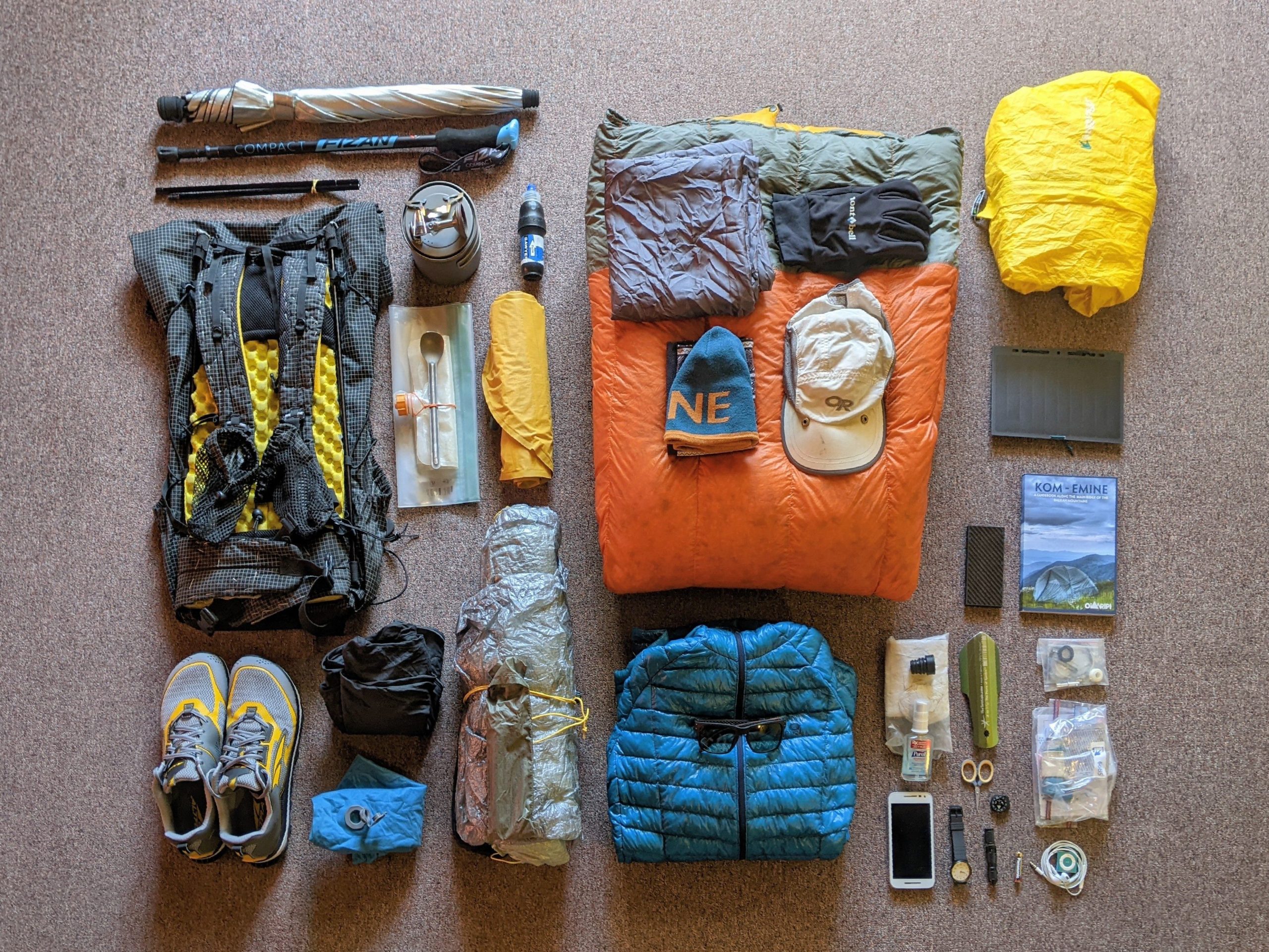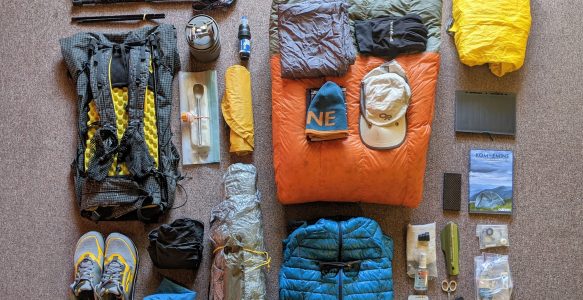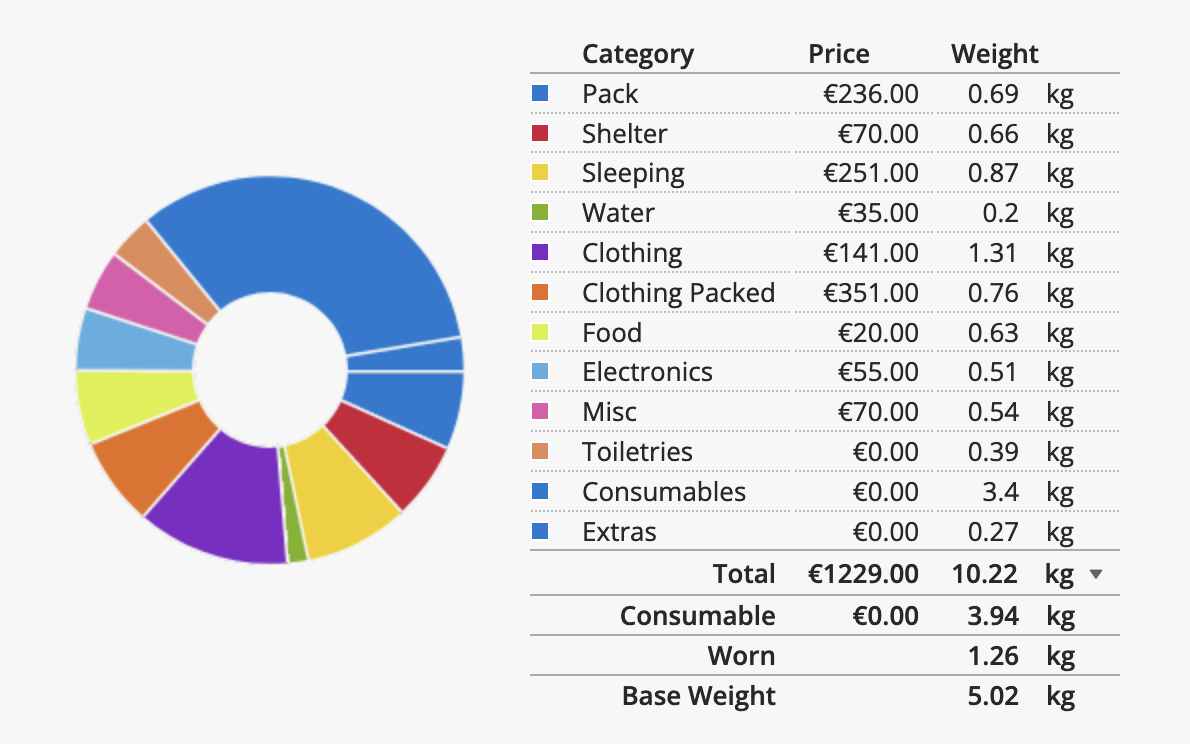The gear I plan to take on the TEAR is much the same as what I took on the PCT in 2018. Here I’ve outlined the main items, as well as some of the changes I’m making this time around. Every hike is an experiment and I still have a lot to learn about what gear works for me under different conditions.
Backpack
The trusty backpack, your friend, your fellow traveler. We seem to develop emotional attachments to our backpacks far more easily than any other piece of equipment. Perhaps it’s because we see it in the photos, and it sits next to us during lunch breaks. Maybe it’s because of all it represents; your freedom, your mobility, your simple life. Anyway, enough keyboard psychologising…
I will be taking my beloved KS50 (circa 2017 from KS ultralight). I’ve now used this pack on every hike of more than a few days since 2017. I’d guess I’ve used it for somewhere around 6000km (in addition to the bigger hikes, it’s been on an untold number of day hikes). The padding on both the hip belt and the shoulders is already fully compressed in places, requiring me to sew on some additional pieces of foam (adding approximately 45g). I see on the KS ultralight website that, as of November 2021, new packs are made with much thicker and stronger padding in the shoulder straps. Great that he (Laurent, the guy who makes them) is responding to feedback, as this is the only criticism I’ve had.
At 50L capacity, it is definitely more than I need. This was in anticipation of carrying a bear-proof container on the PCT, and there the extra volume was appreciated. I think for Europe my ideal volume is somewhere around 40L. However this backpack is still light (608g, even with my extra pockets and padding), and works well for me, so I can’t justify getting a new one just yet.
My hope is that it will last the next 6000km with me on the TEAR, and if so will have earned an honourable retirement.
Shelter
I do have a new shelter for the TEAR… well, sort of. I really loved my TarpTent ProTrail on the PCT. For one person, it’s so spacious inside. I’m around 186cm (just under 6’2″) and I can really stretch out without any fear of touching the sides (possibly letting in dreaded moisture). However I wanted to find something a little lighter. Eventually I ended up choosing a TarpTent ProTrail Li. Yes, it’s the same tent again, just in a lighter (and much more expensive) material. My old tent was 740g, hardly backbreaking, but the new one comes in at just 465g. That’s a saving of 275g! I don’t use exclamation marks often, so you know this is something I’m genuinely excited about. I hope it’s not as sad as it sounds.
It’s not all magic though, since we live in the real world, unfortunately there are trade-offs. The material it’s made from (.51 DCF) isn’t exactly the most hard-wearing. I think I’m quite gentle with my gear, but even so, I think I’ll be especially careful with this tent. Unlike my previous tent I’ll take some repair patches with me. With luck and care, it should last the whole trail. The other major downside to DCF is it’s cost. My regular ProTrail (silnylon) cost $225, whereas the DCF version sells for $500. For such a long distance though, I think it’s worth it (I ran the numbers, over 6 months, it works out to $1.5 more per day).
Sleeping Bag
Okay, since I’m part of the ultralight cult, I’ve bought into the myth that it makes sense to use a quilt (no hood, and not completely sealed underneath) rather than a sleeping bag. Of course it depends on the nature of the trip, for anything much colder than summer in the mountains, I’d probably take a full sleeping bag (if I owned one).
I’ll be taking my Enlightened Equipment Revelation (20oF), which has also been with me since 2016/2017. I’ve not had a problem with it yet. Over the years, it seems to have gained 20g. I don’t know where from, since it’s certainly lost a few feathers. Maybe just dirt and sweat? Still, at 610g, I think it does a great job. And why I really love it? I got to choose the colours.
Sleeping Mat
This will be an experiment in comfort for me. For most of my trips (including the PCT) I’ve used a short foam mat; 6 sections of Therm-a-Rest z-lite, which goes from my thigh to my shoulder, since these are the only places I really need cushioning as a side sleeper. This foam mat weighs 185g, and it does the job fine, but it’s not comfortable. That is unless I happen to be sleeping on an already soft surface (deep grass, lots of old pine needles, you get the idea). But now in my old age (28) I think I’m ready to treat myself to the comfort I denied myself in my youth (24). I had an old Therm-a-Rest NeoAir inflatable pad from the days when I was still reducing my pack weight, but at 350g it’s just too heavy for this kind of trip.
Then I remembered seeing online that lots of people had cut their pads (same model) with great success. Now I must say, it was a real test of faith in internet-people to take a pair of scissors to a €120 inflatable sleeping mat (if it leaks air at all, it’s useless). But there were enough people online claiming that it’s really easy, and that it does work. So I said “what the hell” and went for it. I’m happy to report that the internet-people can now number me among them.
My new inflatable pad still goes from my hip/thigh to my shoulder. The new weight is 200g, for a saving of 150g. That’s only 15g heavier than my foam pad, and a lot more comfortable. There is now however a big height difference between where my hip rests and where my feet rest. I’ve tried it out for a couple of nights and it seemed okay. Time will tell. I can always switch back.


Cooking
This is where most of my weight savings (from my new tent) are being spent. On the PCT I didn’t take a stove, and I thought it was fine. Although I did end up eating cold instant mashed potatoes 90% of the time. As you may guess from that, I don’t need culinary variety. I felt confident doing this as the supermarkets along the trail all sell essentially the same things. Also on the PCT I was sending myself resupply boxes, so I always knew what I was going to be eating.
The TEAR however will (hopefully) be a bit different. I won’t be sending myself packages, and so will be at the mercy (regarding food selection) of whatever towns and villages I pass through. A stove will give me more flexibility, as I can then also buy food that needs cooking. I suppose having warm food is a secondary benefit.
The stove itself (a Soto Windmaster) is light, at only 66g. However I would then also need a metal pot for cooking (130g) as well as the gas to cook with (230g of gas in a 150g canister). That makes a total of 576g, over 500g more than the plastic food container I took on the PCT. Of course that’s not the whole picture. The dehydrated food I can cook may well be lighter, it really depends.
I’m very happy to start with a stove, and if I feel I don’t need it, switch to “no-cook” options.
Solar Panel (10w)
This is the last of my (intentional) gear experiments. Usually I just hike with a 10000mAh battery, which will last me about a week (I’ve never completely run out of battery, so I’m not certain). For this hike I thought it would be fun to try out a solar panel, and at 84g it’s not a big weight commitment.
I’ve had good experiences with solar panels which are static, such as in a window, or in/on a parked vehicle. But I remain sceptical about their effectiveness whilst moving, such as on the top of a backpack. The few test hikes I’ve done with one haven’t been overwhelming, but maybe the conditions weren’t quite right. On the TEAR I’ll have plenty of opportunity to test it out in a variety of conditions.
Small Stuff
As well as the bigger gear decisions, I believe that fine-tuning the small stuff also makes sense. So here is an example of that. I took a small multi-tool on the PCT, but never really needed the (already small) knife. The main tool I used was the scissors (mostly for cutting nails), and sometimes the tweezers. So for the TEAR, I am only taking those things. My multi tool weighs 41g; my new separate (titanium) scissors and tweezers only 8g. That’s 33g less! Come on dear reader, get excited. The scissors are slightly less functional, but the tweezers much more so.


Full Breakdown
You can find all of my gear, including weights at this LighterPack link:













